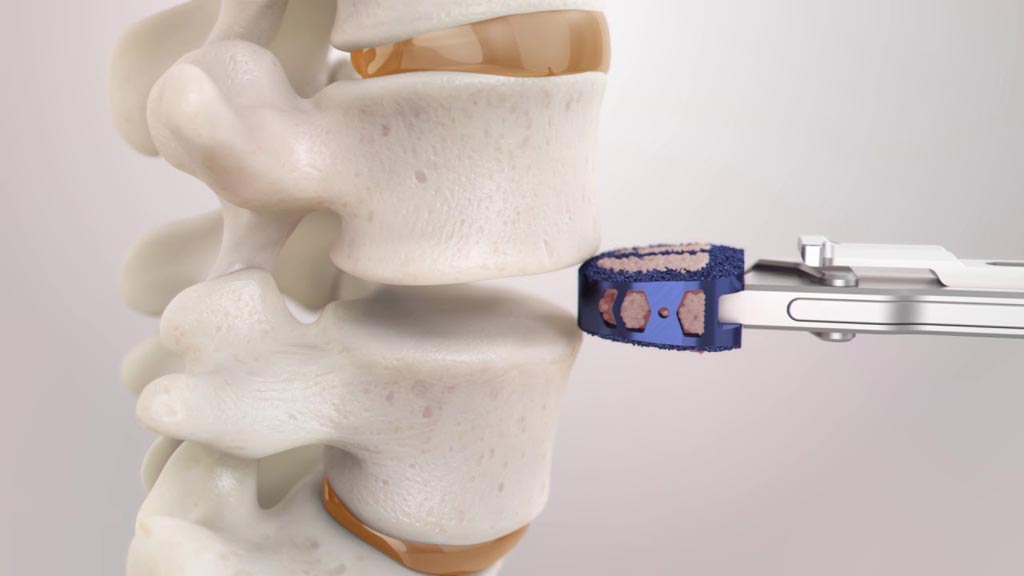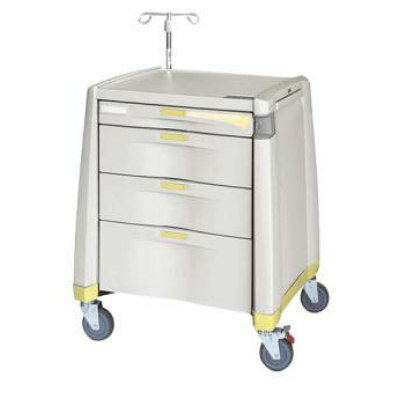Interbody Fusion Implant Fully Integrates with Vertebral Bodies
|
By HospiMedica International staff writers Posted on 06 Nov 2018 |

Image: The ENZA-A Titanium ALIF system (Photo courtesy of Camber Spine Technologies).
A new minimally invasive anterior lumbar interbody fusion (ALIF) device provides support and integrated fixation.
The Camber Spine Technologies (Wayne, PA, USA) ENZA-A Titanium ALIF system is an interbody fusion device indicated for use with autogenous bone graft in patients suffering from degenerative disc disease (DDD) at one or two contiguous levels from L2 to S1. The implants may be placed via a laparoscopic or an open anterior approach, and feature two anchor plates—housed within the three-dimensional (3D) printed titanium body—that are deployed into adjacent vertebrae to provide fixation. The use of supplementary fixation systems is also recommended.
ENZA-A Titanium ALIF has a roughened surface texture designed to encourage bone growth onto the cranial and caudal surfaces of the device. The upper and lower facets are deliberately designed with pores that average a large 500 microns in diameter, the optimal environment for bone ingrowth. In addition, the implant has multiple openings that allow large volumes of autogenous bone graft to be easily packed inside, further facilitating fusion. Proprietary inline instrumentation is used to insert the device, deploy the anchor plates, and lock it in place.
“ENZA-A leverages two of Camber Spine's highly innovative platform technologies,” said Daniel Pontecorvo, CEO of Camber Spine Technologies. “The vast interest and success of our first generation ENZA with Duo Presa anchor technology and our line of SPIRA products with Surface By Design inspired us to combine their defining attributes to create this next generation ENZA-A Titanium ALIF.”
Interbody devices are designed to replace the intervertebral disc of the spine, enhancing stability in the region while the spine fuses. Over time, the packed bone graft material is gradually replaced by natural bone. Fusion procedures also typically use a posterior fixation device to the associated level, since the surgeons will implant interbody devices from an anterior approach and flip the patient over to implant a posterior pedicle screw device. This combination increases fusion success.
Related Links:
Camber Spine Technologies
The Camber Spine Technologies (Wayne, PA, USA) ENZA-A Titanium ALIF system is an interbody fusion device indicated for use with autogenous bone graft in patients suffering from degenerative disc disease (DDD) at one or two contiguous levels from L2 to S1. The implants may be placed via a laparoscopic or an open anterior approach, and feature two anchor plates—housed within the three-dimensional (3D) printed titanium body—that are deployed into adjacent vertebrae to provide fixation. The use of supplementary fixation systems is also recommended.
ENZA-A Titanium ALIF has a roughened surface texture designed to encourage bone growth onto the cranial and caudal surfaces of the device. The upper and lower facets are deliberately designed with pores that average a large 500 microns in diameter, the optimal environment for bone ingrowth. In addition, the implant has multiple openings that allow large volumes of autogenous bone graft to be easily packed inside, further facilitating fusion. Proprietary inline instrumentation is used to insert the device, deploy the anchor plates, and lock it in place.
“ENZA-A leverages two of Camber Spine's highly innovative platform technologies,” said Daniel Pontecorvo, CEO of Camber Spine Technologies. “The vast interest and success of our first generation ENZA with Duo Presa anchor technology and our line of SPIRA products with Surface By Design inspired us to combine their defining attributes to create this next generation ENZA-A Titanium ALIF.”
Interbody devices are designed to replace the intervertebral disc of the spine, enhancing stability in the region while the spine fuses. Over time, the packed bone graft material is gradually replaced by natural bone. Fusion procedures also typically use a posterior fixation device to the associated level, since the surgeons will implant interbody devices from an anterior approach and flip the patient over to implant a posterior pedicle screw device. This combination increases fusion success.
Related Links:
Camber Spine Technologies
Latest Surgical Techniques News
- Robotic Assistant Delivers Ultra-Precision Injections with Rapid Setup Times
- Minimally Invasive Endoscopic Surgery Improves Severe Stroke Outcomes
- Novel Glue Prevents Complications After Breast Cancer Surgery
- Breakthrough Brain Implant Enables Safer and More Precise Drug Delivery
- Bioadhesive Sponge Stops Uncontrolled Internal Bleeding During Surgery
- Revolutionary Nano Bone Material to Accelerate Surgery and Healing
- Superior Orthopedic Implants Combat Infections and Quicken Healing After Surgery
- Laser-Based Technique Eliminates Pancreatic Tumors While Protecting Healthy Tissue
- Surgical Treatment of Severe Carotid Artery Stenosis Benefits Blood-Brain Barrier
- Revolutionary Reusable Duodenoscope Introduces 68-Minute Sterilization
- World's First Transcatheter Smart Implant Monitors and Treats Congestion in Heart Failure
- Hybrid Endoscope Marks Breakthrough in Surgical Visualization
- Robot-Assisted Bronchoscope Diagnoses Tiniest and Hardest to Reach Lung Tumors
- Diamond-Titanium Device Paves Way for Smart Implants that Warn of Disease Progression
- 3D Printable Bio-Active Glass Could Serve as Bone Replacement Material
- Spider-Inspired Magnetic Soft Robots to Perform Minimally Invasive GI Tract Procedures
Channels
Critical Care
view channel
CPR Guidelines Updated for Pediatric and Neonatal Emergency Care and Resuscitation
Cardiac arrest in infants and children remains a leading cause of pediatric emergencies, with more than 7,000 out-of-hospital and 20,000 in-hospital cardiac arrests occurring annually in the United States.... Read more
Ingestible Capsule Monitors Intestinal Inflammation
Acute mesenteric ischemia—a life-threatening condition caused by blocked blood flow to the intestines—remains difficult to diagnose early because its symptoms often mimic common digestive problems.... Read more
Wireless Implantable Sensor Enables Continuous Endoleak Monitoring
Endovascular aneurysm repair (EVAR) is a life-saving, minimally invasive treatment for abdominal aortic aneurysms—balloon-like bulges in the aorta that can rupture with fatal consequences.... Read more
Wearable Patch for Early Skin Cancer Detection to Reduce Unnecessary Biopsies
Skin cancer remains one of the most dangerous and common cancers worldwide, with early detection crucial for improving survival rates. Traditional diagnostic methods—visual inspections, imaging, and biopsies—can... Read morePatient Care
view channel
Revolutionary Automatic IV-Line Flushing Device to Enhance Infusion Care
More than 80% of in-hospital patients receive intravenous (IV) therapy. Every dose of IV medicine delivered in a small volume (<250 mL) infusion bag should be followed by subsequent flushing to ensure... Read more
VR Training Tool Combats Contamination of Portable Medical Equipment
Healthcare-associated infections (HAIs) impact one in every 31 patients, cause nearly 100,000 deaths each year, and cost USD 28.4 billion in direct medical expenses. Notably, up to 75% of these infections... Read more
Portable Biosensor Platform to Reduce Hospital-Acquired Infections
Approximately 4 million patients in the European Union acquire healthcare-associated infections (HAIs) or nosocomial infections each year, with around 37,000 deaths directly resulting from these infections,... Read moreFirst-Of-Its-Kind Portable Germicidal Light Technology Disinfects High-Touch Clinical Surfaces in Seconds
Reducing healthcare-acquired infections (HAIs) remains a pressing issue within global healthcare systems. In the United States alone, 1.7 million patients contract HAIs annually, leading to approximately... Read moreHealth IT
view channel
Printable Molecule-Selective Nanoparticles Enable Mass Production of Wearable Biosensors
The future of medicine is likely to focus on the personalization of healthcare—understanding exactly what an individual requires and delivering the appropriate combination of nutrients, metabolites, and... Read moreBusiness
view channel
Philips and Masimo Partner to Advance Patient Monitoring Measurement Technologies
Royal Philips (Amsterdam, Netherlands) and Masimo (Irvine, California, USA) have renewed their multi-year strategic collaboration, combining Philips’ expertise in patient monitoring with Masimo’s noninvasive... Read more
B. Braun Acquires Digital Microsurgery Company True Digital Surgery
The high-end microsurgery market in neurosurgery, spine, and ENT is undergoing a significant transformation. Traditional analog microscopes are giving way to digital exoscopes, which provide improved visualization,... Read more
CMEF 2025 to Promote Holistic and High-Quality Development of Medical and Health Industry
The 92nd China International Medical Equipment Fair (CMEF 2025) Autumn Exhibition is scheduled to be held from September 26 to 29 at the China Import and Export Fair Complex (Canton Fair Complex) in Guangzhou.... Read more












